
Bloomington is a city in and the county seat of McLean County, Illinois, United States. It is adjacent to the town of Normal, and is the more populous of the two principal municipalities of the Bloomington–Normal metropolitan area. Bloomington is 135 miles (217 km) southwest of Chicago and 162 miles (261 km) northeast of St. Louis. The 2020 census showed the city had a population of 78,680, making it the 13th-most populated city in Illinois and the fifth-most populous outside the Chicago Metropolitan Area. Combined with Normal, the twin cities have a population of roughly 130,000. The Bloomington area is home to Illinois Wesleyan University and Illinois State University. It also serves as the headquarters for State Farm Insurance and Country Financial.
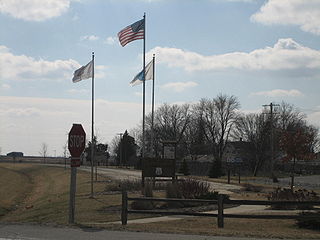
Towanda is a village in McLean County, Illinois, United States. The population was 431 at the 2020 census. It is part of the Bloomington–Normal Metropolitan Statistical Area.

The Ellwood House was built as a private home by barbed wire entrepreneur Isaac Ellwood in 1879. It is located on First Street in DeKalb, Illinois, United States, in DeKalb County. The Victorian style home, designed by George O. Garnsey, underwent remodeling in 1898-1899 and 1911. The house was originally part of 1,000 acres (4.0 km2) which included a large stable complex known as "Ellwood Green." Isaac Ellwood lived here until 1910 when he passed the estate to his son, Perry Ellwood.

Leroy Kershaw (1880–1969) was an American attorney, banker, businessman, cattleman and political candidate.

Rose Hill Manor, now known as Rose Hill Manor Park & Children's Museum, is a historic home located at Frederick, Frederick County, Maryland. It is a 2+1⁄2-story brick house. A notable feature is the large two-story pedimented portico supported by fluted Doric columns on the first floor and Ionic columns on the balustraded second floor. It was the retirement home of Thomas Johnson (1732–1819), the first elected governor of the State of Maryland and Associate Justice of the United States Supreme Court. It was built in the mid-1790s by his daughter and son-in-law.
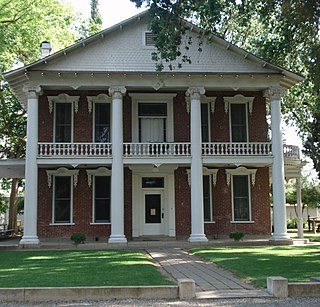
The Gibson House is a historic house that now serves as a museum in Woodland, California. It exemplifies several architectural styles, including Georgian Revival, Italianate and Neoclassical. It was listed in the National Register of Historic Places in 1976.

Lynfeld is a farm located on South Road in the Town of Washington, New York, United States, near the village of Millbrook. Its farmhouse, a frame structure dating to the late 19th century, is in an unusual shape for a building in the Italianate architectural style.

Skene Manor, listed on the National Register of Historic Places as Judge Joseph Potter House, is a historic home located at Whitehall in Washington County, New York. It was built in 1874 and is a handsome Victorian style mansion built of grey sandstone quarried from its own site with a mansard roof. It features two towers and is embellished with three flat roofed bracketed porches. The center tower is three and one half stories and once featured a large clock that has been removed. The mansion was operated as a restaurant, but is now undergoing restorations and is open for tours.

The Robert Milne House is a historic residence in Lockport, Illinois, United States. It was home to Robert Milne, Canal Commissioner of the Illinois and Michigan Canal.

Hillside, also known as the Charles Schuler House, is a mansion overlooking the Mississippi River on the east side of Davenport, Iowa, United States. It has been individually listed on the National Register of Historic Places since 1982, and on the Davenport Register of Historic Properties since 1992. In 1984 it was included as a contributing property in the Prospect Park Historic District.

The Oscar C. Woods House is a historic building located on the east side of Davenport, Iowa, United States. It has been listed on the National Register of Historic Places since 1984.

The Louis C. and Amelia L. Schmidt House is a historic building located in a residential neighborhood on the east side of Davenport, Iowa, United States. It was listed on the National Register of Historic Places in 2007.

The Flynn Farm, Mansion, and Barn, also known as the Flynn Farm, Walnut Hill Farm, Clive Honor Farm, comprise a historic district located near Des Moines, Iowa, United States. It was listed on the National Register of Historic Places in 1973.
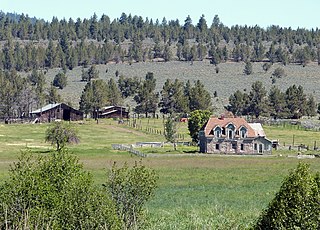
The Roba Ranch is a pioneer ranch located near the small unincorporated community of Paulina in Crook County, Oregon. The ranch is named for George and Mary Roba, sheep ranchers who acquired the property in 1892. Most of the important ranch buildings were constructed by the Roba family between about 1892 and 1910. Today, the ranch covers 1,480 acres (6.0 km2) and is privately owned. The ranch was listed on the National Register of Historic Places in 2007.

The Henry Clay Moss House is a historic house located at 414 N. Main St. in Paris, Illinois. The Italianate house was built in 1876 for local businessman Henry Clay Moss. The home features a wraparound porch supported by columns, a hipped roof with a bracketed cornice, and a projecting hexagonal bay on its west side. The interior of the home includes home office space and features decorative wooden door and window surrounds and trim as well as a cantilevered flight of stairs. Moss lost the house in 1877, and it passed through a succession of owners until livestock breeder Daniel Arthur bought the home in 1895; the home remained in the Arthur family until 1976.

Roberson-Everett-Roebuck House is a historic home located at Robersonville, Martin County, North Carolina. It was built about 1900, and is a 1+1⁄2-story, Queen Anne style frame cottage. It has a steeply pitched hipped roof with central tower, lower cross gables, front porch, and a double-pile center hall plan. The house features decorative woodwork including exterior gable ornaments, bracketed cornices, and the front porch balustrade and spindle frieze. Also on the property is a contributing combination wood and smokehouse.

The Price-Prather House is a historic house located at the intersection of Main and Elkhart Streets in Williamsville, Illinois. The house was built in 1868 for livestock breeder James R. Price. The Italianate house features a multi-component slate roof, a bracketed and dentillated cornice, a wraparound front porch, and long arched windows with brick hoods. Cattle breeder John F. Prather purchased the house in 1882. Prather was an influential Shorthorn cattle breeder; as one of the earliest cattlemen to breed shorthorns in Illinois, he became recognized as an authority on the breed, and he served as president of the American Shorthorn Association and a member of the State Board of Agriculture.
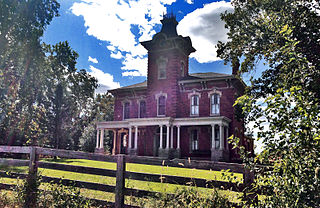
The Caldwell Farmstead is a historic farmhouse located on Illinois Route 4 north of Chatham, Sangamon County, Illinois. The two-story Towered Italianate house was built in 1876. The red brick house features detailed joint work on the corners and groups of tall windows with molded hoods. A front porch supported by Roman columns runs along the front of the house. Decorative brackets adorn the wide eaves of the house's hip roof. A three-story tower with a steeply sloped cupola, the principal element of the Towered Italianate style, rises above the front entrance. The house is one of the few Towered Italianate homes in Central Illinois; similarly styled homes in the Springfield area include the George M. Brinkerhoff House and the Rippon-Kinsella House.
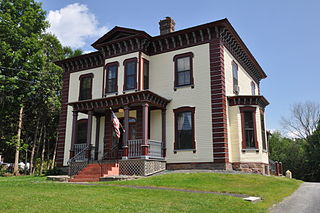
The Colby Mansion is a historic house on Vermont Route 100 in Waterbury, Vermont. It was built in 1870 by George J. Colby, a proponent of ideas of house construction for healthy living, and exhibits all of the major features of his published works. It was listed on the National Register of Historic Places in 1979.

The Morton Mansion was built in 1903 in Douglas, Wyoming for the family of John Morton. Morton was a sheep rancher who also served as an elected official, banker and civic leader in Douglas. The house was designed by Wyoming architect William DuBois.






















